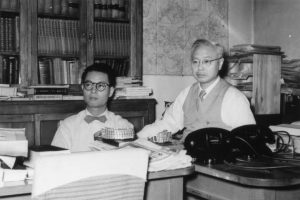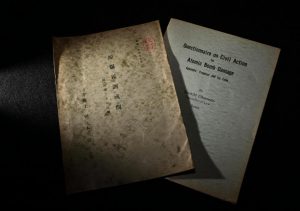Striving to fill voids in Hiroshima, unfinished judgment, Part 3: Questionnaire on Civil Action for Atomic Bomb Damage
Apr. 24, 2024
Called for lawsuit against U.S., based on idea that A-bombings were “illegal”
After returning to his law office in Osaka in 1953, five years after a ruling was handed down in the International Military Tribunal for the Far East (Tokyo Trial), attorney Shoichi Okamoto wrote a nine-page booklet titled Questionnaire on Civil Action for Atomic Bomb Damage. His research into the issue led to his belief that the atomic bombings had violated international law and that a civil lawsuit could be filed against the U.S. government and the other leaders involved for compensation. He put together the booklet to convey his ideas about the issue.
The attitude of the United States was what motivated Mr. Okamoto to pursue that path. The booklet includes the phrasing, “Showing the world that a lawsuit for damages is possible would itself contribute to peace.”
No apology or remorse
The Treaty of San Francisco, a peace agreement signed between Japan and the Allied nations, including the United States, took effect on April 28, 1952, and with that, Japan regained its independence. Mr. Okamoto hoped that the agreement would lead the U.S. and other leaders to apologize and express remorse for the atomic bombings. But no such message ever arrived.
Although he was already 60, he set out to study international and U.S. law in the belief that even a single individual could hold the United States accountable in a civil lawsuit. He would even set writing materials at his bedside to record ideas when they arose, said Keiko Murata, 69, Mr. Okamoto’s granddaughter who lives in Ashiya City in Hyogo Prefecture. She still keeps on hand a great number of his reference materials and notes.
The booklet resulting from those efforts explained that a lawsuit could be filed for the reasons indicated below.
One reason was the unparalleled cruelty of the atomic bombings. The powerful blast and thermal rays generated by the bombs destroyed vast areas, killing and injuring many civilians, and the radiation continued to cause suffering. Indiscriminate attacks and the use of weapons that cause unnecessary suffering are prohibited by the Convention Respecting the Laws and Customs of War on Land (Hague Convention). Mr. Okamoto believed there was no doubt that the atomic bombings represented a violation of international law.
The other was respect for human rights. As the basis for his claim of damages, he cited the Universal Declaration of Human Rights, adopted by the United Nations in 1948, which upholds the dignity of all human beings. He also based his idea on the guarantee of fundamental human rights stipulated in the Japanese Constitution, which went into effect in 1947.
Concept receives support
The Treaty of San Francisco stipulated that Japan renounce its right to demand compensation from the United States with respect to damages incurred in the war. However, the victims continued to suffer from the effects of the atomic bombings. Mr. Okamoto made the claim that the renunciation of the right to claim compensation for the atomic bombings was “invalid” from the perspective of the human rights of the victims.
In January 1953, Mr. Okamoto’s concept for the lawsuit was reported in newspapers. Letters of encouragement poured in from victims of the atomic bombings. Among them was a man who had lost his wife, children, and grandchildren in the atomic bombing of Hiroshima. Left alone by the bombing, he was living with relatives in Hyogo Prefecture.
Mr. Okamoto began to write tanka when he was young and later published a collection of the poems. He wrote of his feelings at that time in one of his poems.
“Woke up in the middle of the night, read a letter from a victim, tears streamed down my face, and I cried.” The poem is contained in his poetry collection titled Jinrui (in English, ‘Humankind’).
In March of the same year, Ms. Okamoto traveled to the A-bombed Hiroshima to convey his ideas about the lawsuit.
Keywords
The Treaty of San Francisco
Signed in September 1951 between Japan and 48 Allied nations, the treaty formally ended the state of conflict of World War II in legal terms. The treaty also ended the occupation of Japan by the Allied nations and restored Japan’s independence. Japan renounced its right to demand compensation for damages caused by the Allied nations because of the war, and the signatory Allied nations, with some exceptions, also waived their right of claims against Japan. The resulting “separate peace,” without the Soviet Union or China, set the course for Japan to join the Western bloc of nations.
(Originally published on April 24, 2024)









